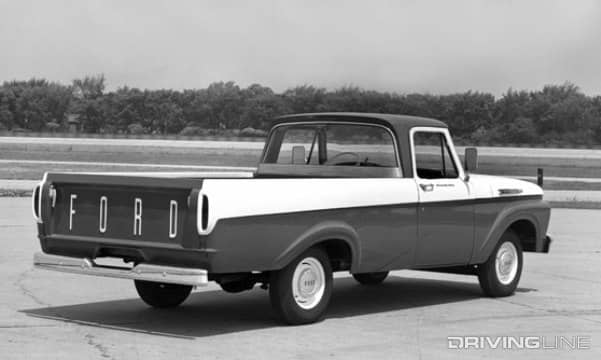True Mavericks: 5 Unconventional Trucks from Ford’s History
Ford has announced their latest pickup offering, the Maverick, and it seems like it will be a welcome return to the world of compact trucks. Sharing much of its design with the recently released Bronco Sport, the Maverick utilizes a unibody chassis based on the same C2 platform as the Ford Escape, albeit beefed up for this application.
As strange of a recipe as that may seem for a pickup, Ford has been experimenting with unconventional trucks for decades. From different takes on conventional models, to completely different takes on what defines a truck, they haven’t been afraid to push the limit.
F100 “Unibody”
In 1961, Ford debuted a variation of the “styleside” bed design that connected the bed and cab portions of the truck. Ford’s intent was to appeal to more aesthetically driven customers that might not need the rugged capability provided by a separate cab. Not exactly a unibody in the truest sense, Ford sold these trucks as “unitized,” and only offered them in 2WD configuration.

The experiment, however, would be short lived. Body flex caused the trucks to warp in such a way that doors could either come open without warning or get stuck, trapping passengers inside. Furthermore, as the trucks aged, the rocker panels would fall victim to rust, and were irreplaceable due to the one-piece design. Phased out in 1963, the surviving trucks have actually earned a cult following as collector trucks, popular for their unique sleek look in a time when trucks were still very much utility vehicles.
Ranchero
Although there have been many car-based pickups, or coupe utilities, the O.G. for the American market is the Ford Ranchero. The coupe utility was an Australian invention, thought of as a do-it-all vehicle for farmers, something that one could “go to church in on a Sunday and which can carry our pigs to market on Mondays.” Released in 1957, the Ranchero would be produced over a span of seven generations in the US until 1979.

There were a huge variety of powerplants offered over the nearly twenty year lifespan, ranging from a 2.4L straight six to a 7.0L V8. The Ranchero was never intended to compete in the traditional truck market, but rather offer the utility of a bed with the comfort and handling of Ford’s modern passenger cars. The top of the pack would be available last in 1971 in Super Cobra Jet spec with a “Shaker” hood and 375hp on tap.
Ford Courier Electravan
When the gas crisis hit in the early 1970s, Ford joined other domestic brands in rebadging Japanese compact trucks for their own use in the American market. Ford tapped into Mazda’s lineup with the B-series pickup, and would sell it domestically until developing their own Ranger in the ‘80s. The Courier was largely a conventional truck throughout its lifetime, with one notable exception.

Between 1979 and 1982, now defunct Jet Industries converted Couriers into EV trucks by mounting a series of lead-acid batteries in the bed. Chargeable by a household 110-series outlet, the Electravan was powered by a 30 horsepower motor. Although limited by the technology of the time, this early attempt at an electric truck would foreshadow the desire for such a vehicle in the future.
Ford Ranger EV
Although Ford wasn’t directly involved in the EV production of the Electravan, they would do their own experimentation in the space with their Ford Ranger EV. First available in 1998, the trucks were only available for lease, primarily by commercial clients. The first models were sold with lead-acid batteries, but swapped to more modern NiMH batteries in the second year.

With a maximum range of 82 miles, the Ranger EV was actually a pretty decent proposition for in-town daily duties. The electric motor provided 90hp to the rear wheels, and while that didn’t necessarily catch the attention of enthusiasts, it wouldn’t have felt out of line for contemporary small pick-ups. While all of the Ranger EVs were recalled by 2004, one can imagine that Ford learned a few lessons from this experiment that proved useful for their design of the new, electric F150 Lightning.
Ford F1000
While the rest of the list has focused on American-market vehicles, the strangest of the bunch hails from Brazil. The 5th generation F100 began production in the South American country in 1972, and lasted until 1992. The heavy-duty version was deemed the F1000, and was available with a 4-cylinder 3.9L diesel engine available in both naturally-aspirated and turbocharged versions.

The strangest aspect of the F1000, however, were the strange body configurations available. An authorized Ford coachbuilder, Sulamericana, received zero-mile bodies and took the design to absolute bonkers levels. The Galaxia model was a double-cab setup with a closed trunk-like bed that resembled a distorted, bizarre sedan.







